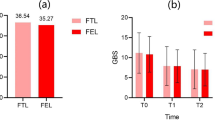Abstract
Acanthosis nigricans is a common dermatological problem. There are currently limited clinical trials to determine the efficacy and safety of laser treatments. To compare the efficacy of fractional 1550-nm erbium fiber laser versus 0.05% tretinoin cream for the treatment of acanthosis nigricans at neck, a randomized, controlled, assessor-blinded study was conducted in 18 subjects with acanthosis nigricans at the neck. All patients were treated with both fractional 1550-nm erbium fiber laser and 0.05% tretinoin cream on each side of the neck. The laser side was treated with three treatment sessions, with a 4-week interval of 1550-nm fractional erbium laser. Another side was treated with 0.05% tretinoin cream daily at bedtime for 12 weeks. We evaluated at baseline, with a 4-week interval until 4 weeks after the last treatment. The efficacy was assessed by skin color ratio, melanin index, average roughness, photographic evaluation, patients’ satisfaction, and the adverse effects. At the study endpoint, week 12, the mean Visiometer-average roughness showed greater reduction in laser-treated side (24.65%) than tretinoin side (22.94%) (p = 0.004). Laser-treated side also showed greater percentage of skin color ratio reduction, melanin index reduction, and better mean of photographic-based evaluation percentage change from the baseline than tretinoin side with no significant different (p = 0.331, p = 0.116, p = 0.327, respectively). The study showed one post-inflammatory hyperpigmentation in tretinoin side. Regarding to the average roughness, fractional 1550-nm erbium fiber laser was superior to 0.05% tretinoin cream for treatment of neck-acanthosis nigricans with less side effect. Fractional 1550-nm erbium fiber laser could be considered as an alternative treatment for acanthosis nigricans.





Similar content being viewed by others
References
Phiske MM (2014) An approach to acanthosis nigricans. Indian J Dermatol 5(3):239–249
Kutlubay Z, Engin B, Bairamov O, Tüzün Y (2015) Acanthosis nigricans: a fold (intertriginous) dermatosis. Clin DermatolClin Dermatol 33(4):466–470
Sinha S, Schwartz RA (2007) Juvenile acanthosis nigricans. J Am Acad DermatolJ Am Acad Dermatol 57(3):502–508
Ehsani A, Noormohammadpour P, Goodarzi A, Mirshams Shahshahani M, Hejazi SP, Hosseini E et al (2016) Comparison of long-pulsed alexandrite laser and topical tretinoin-ammonium lactate in axillary acanthosis nigricans: a case series of patients in a before-after trial. Caspian J Intern Med 7(4):290–293
Treesirichod A, Chaithirayanon S, Wongjitrat N (May) Comparison of the efficacy and safety of 0.1% adapalene gel and 0.025% tretinoin cream in the treatment of childhood acanthosis nigricans. Pediatr DermatolPediatr Dermatol 36(3):330–334
Laubach H-J, Tannous Z, Anderson RR, Manstein D (2006) Skin responses to fractional photothermolysis. Lasers Surg MedLasers Surg Med 38(2):142–149
Lahiri K, Malakar S (1996) Topical tretinoin in acanthosis nigricans. Indian J Dermatol, Venereol and Leprol 62(3):159–161
Rosenbach A, Ram R (2004) Treatment of acanthosis Nigricans of the axillae using a long-pulsed (5-msec) alexandrite laser. Dermatol SurgDermatol Surg 30(8):1158–1160
Zaki NS, Hilal RF, Essam RM (2018) Comparative study using fractional carbon dioxide laser versus glycolic acid peel in treatment of pseudo-acanthosis nigricans. Lasers Med Sci 33(7):1485–1491
Author information
Authors and Affiliations
Corresponding author
Ethics declarations
This study has been approved by the Clinical Research Ethical Committee of Srinakharinwirot University and followed the 1964 Helsinki declaration. All patients signed informed consent before participating in the study.
Conflict of interest
The authors declare that they have no conflict of interest.
Additional information
Publisher’s note
Springer Nature remains neutral with regard to jurisdictional claims in published maps and institutional affiliations.
Rights and permissions
About this article
Cite this article
Leerapongnan, P., Jurairattanaporn, N., Kanokrungsee, S. et al. Comparison of the effectiveness of fractional 1550-nm erbium fiber laser and 0.05% tretinoin cream in the treatment of acanthosis nigricans: a prospective, randomized, controlled trial. Lasers Med Sci 35, 1153–1158 (2020). https://doi.org/10.1007/s10103-019-02944-9
Received:
Accepted:
Published:
Issue Date:
DOI: https://doi.org/10.1007/s10103-019-02944-9




